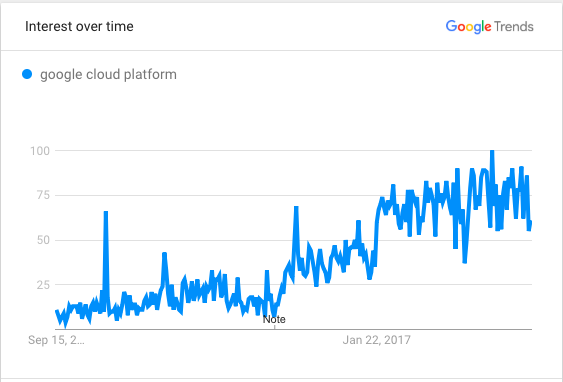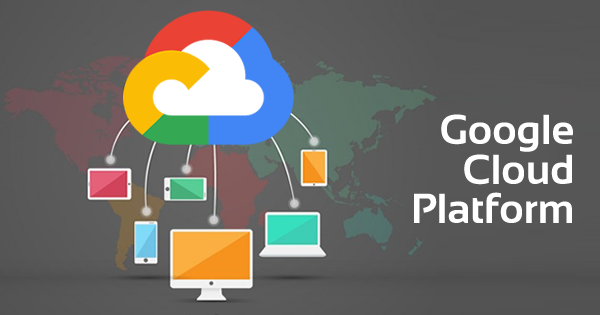2022-23 was a good year for Google Cloud Platform but 2024 promises to be better.
Let’s explore what’s next the Google Cloud will bring i.e. what are the Google Cloud Trends for 2024!
Cloud Computing in its most basic form is just storing your data at a remote location to ensure that if anything wrong happens to you or your existing framework, the information generated through the system will still remain intact. This is essentially considered as a fancy way of keeping a backup. However, the ability of the Cloud to be accessed from anywhere opened up a whole lot of avenues for companies to explore, as they finally found a way to mobilize their data in a way that wasn’t thought of before.
Preparing to become a GOOGLE CERTIFIED PROFESSIONAL Cloud Architect? Try Google Cloud Architect Free Practice Questions now!
Instead of using Cloud backups for just storage, many developers have started building an entire ecosystem of applications, software, and other utilities that use the cloud as a backbone, thus reducing the resources required a lot while retaining the mobile quality of the cloud.
This new type of computing has been gaining a lot of traction lately, as the ecosystem we mentioned has grown into a multibillion-dollar industry. So, most of the tech giants don’t have their own type of cloud service for both clients and customers. We are here to talk about one of them, Google.
Some of the services offered by Google are Google App Engine, Gmail, Google Docs, Google BigQuery Service, and Google Cloud Dataflow among so many available. Together combined, these services form the Google Cloud Platform. Here is the growth of Google Cloud in the past 5 years as per Google trends –

The Google Cloud Platform is divided into different segments based on the cloud products in question, which in turn are then based on the types of services they offer, whether it be just storing data, storing data and using services or storing data using services and creating your own experiences, i.e. IaaS (Infrastructure-as-a-Service), SaaS (Software-as-a-Service) and PaaS (Platform-as-a-Service) respectively.
Google Cloud Trends for 2024
Google has been a pioneer in creating such services, and thus, whatever they do, becomes a future trend in the cloud computing market, in general. So without further adieu, here are the 2024 Cloud predictions for Google Cloud Platform, say Google Cloud trends. Let us have a look at the upcoming Google Cloud trends now:
Growth in Size
Growth is less of a trend and more of a goal to aspire to. The Cloud Computing market is expected to keep hitting this goal by the end of the year 2018. Thanks to the widespread adoption of various SaaS, PaaS, and IaaS services. These services are predicted to post a growth rate of around 18%, thus pushing the adoption rates over 50% and generating billions in revenue.
This growth can be attributed to the easy nature of implementation as well as the ability of the platform to serve hundreds of customers in various locations, irrespective of their hardware setup. This is why Google invests heavily in it. So much so, their total investment to date is over $30 billion dollars.
Google Cloud trends, in the wider sense, are the Cloud Computing trends. So, broaden your knowledge with our previous blog on Cloud Computing trends.
Growth in Storage Capacity
With a growing number of people adopting Google Cloud solutions, it is expected that the total data stored on the cloud will also increase as these new customers start dumping their data to the cloud for safekeeping and smart use. To meet this increased load in data volume, most companies that offer cloud services have been steadily increasing their internal storage capacity as well.
The year 2017 has been a great example of this, as in one year alone, the global cloud storage capacity had reached a respectable size of around 600 EB (Exabyte). If this number seems intimidating, then it would positively shock you to know that it is set to double by the end of 2018, to an approximate 1.1 ZB (Zettabyte), as long as this trend keeps going. Google will definitely play a big role in creating this capacity, considering their billions in investment.
Growth in Cheaper Storage Solutions
This increase in storage capacity has helped mitigate the inflation that is expected to hit any industry, is seeing such growth in demand as Cloud Computing. In fact, the investment being made in storage capacity increase is at such a scale that it has pushed the prices down to less than 10 cents for 1 TB of cloud storage.
This is why Google has been able to offer their services at a much more affordable price that you would expect from such a big company. In fact, it is a known fact that they offer 15Gb of free cloud storage with every Google Drive account. That is not a small value considering how many millions of Google account exists across the globe. As per Google Cloud Market Analysis, this value is expected to grow going forward.
Growth in Server-less Cloud Computing
Initial cloud computing architecture had a lot of connections to older generation systems that had limitations in terms of cloud usage. This forced them to integrate servers as a part of their cloud process since most companies used them as a means of primary storage and couldn’t completely rely on cloud services alone, as at that stage the services were neither as reliable as they are now nor as cheap.
Note that keeping data on the cloud is so easy, more and more developers are changing their Cloud Computing architecture to support and encourage Server-less Cloud Computing. Since these new generations of applications don’t need any physical infrastructure to run, they can easily be deployed on a lot of systems that would not have been able to use them before.
This is one of the important Google Cloud trends and one of the leading ways of improving efficiency while reducing effort and cost. Google is definitely leading this trend with its host of services that have no physical footprint at all, such as Gmail and Google Docs.
New in the world of Cloud Computing? Read this quick Introduction to Cloud Computing to know what’s behind its growing importance.
Growth in Cloud-Based Container Systems
Since we were talking about replacing hardware in favor of cloud services, it is important that we focus on replacing software as well. The reason is that most systems only require hardware to execute specific operating systems that are essential to running various applications. After all, this is a reason why so much of your android hardware resources are used up by the system itself.
With the development of newer and better cloud-based services, Google has also started working on newer and better systems to deploy these services, without the use of traditional operating systems. These systems are called Cloud-based container systems. These containers contain the entire package: an application, plus all its dependencies, libraries and other binaries, and configuration files needed to run it.
By having such systems in place, the software companies can test and deploy new software with ease, thus rendering both virtual machines and operating systems in a redundant manner. To put this in perspective, imagine if the next version of Facebook was developed in the container itself and then deployed on the phone in the same container, without the need for the Android operating system itself. While this will certainly not replace the operating system anytime soon, it will still act as a direction that needs to be explored more.
Growth in the Internet of Things (IoT)
The new types of serverless cloud services and self-contained app containers are set to revolutionize the tech industry, as this ecosystem will help integrate computing into a lot of devices that had no options like this before. We are talking about all types of home and office devices such as lights, air conditioning units, refrigerators, washing machines, cars etc. This new type of connectivity is being called the Internet of Things.
Google in the Internet of Things is one of the upcoming Google Cloud Trends that is expected to bring a new era of cloud computing. Google has been working on a new generation of the operating system that will not only integrate these devices as part of the ecosystem but also use the data generated by them to create better solutions for both customers and companies that are looking to get their product on the Google platform.
AWS and Azure are the two main competitors of the Google Cloud in the cloud market. Let’s have a comparison between three – AWS vs Azure vs Google
Growth in Network Speeds
One of the key aspects of having a cloud-based system is perpetual connectivity. As long as you have a stable internet connection, you can access cloud services from anywhere at any time. While there is a great boon, it is also a severe limitation as a stable internet connection is not something that everyone who uses these services can boast about.
LTE as an internet standard has really helped solve this issue to a certain extent, but we have already reached the limits of this technology. Which is why we are so excited about Google’s work in this field under their Google Fiber brand. Google Fiber has proved to be a great option for high-speed internet in both residential and commercial settings.
As the company expands its services to various parts of the world, it will also help in improving the adoption of IoT devices and Cloud-based services offered by Google, since they will be optimized to make the best use of the high-speed internet connectivity. It is not wrong to place network speeds in the Google Cloud trends because the Cloud itself has become the other name for the Internet.
Growth in Cloud-Based Blockchain Services
None of these services are worth anything if they are not secure enough to keep your data from being tampered with external forces. Which is why when the first time blockchain as a technology was revealed to the world, the populace embraced it in the open arms. Bitcoin has already shown what this service can do for decentralized information storage. Which is why Google is now working towards including this technology in their existing and upcoming products, as a means of creating more transparency and accountability in the system.
Final Words
There was a number of Google Cloud trends in 2017-18, this year won’t be different and will bring some more amazing Google Cloud trends. All of the above-mentioned and more will form the trends that will shape the future of the Google Cloud Platform in 2024 and many more years to come. It is a great area to simply observe since the work being done here is literally changing the world for the better.
With the continuous growth of Google Cloud Platform and upcoming Google Cloud trends, the demand for Google Cloud professionals (Like GCP professional cloud architect & Google Cloud Professional Data Engineer) is increasing in the cloud computing domain and a Google Cloud certification validates one’s expertise on Google Cloud Platform.
Millions of cloud professionals enhancing their careers with the help of Cloud Computing Certification training courses. Whizlabs, knowing the importance of certification, comes with the Google Certified Professional Cloud Architect practice tests to help you prepare for the Google Professional Cloud Architect certification exam.
Start your preparation now and be a part of the Google Cloud world!
Have any questions regarding Google Cloud Platform? Just mention in the comment below or submit in Whizlabs Helpdesk, we’ll respond in no time.
- Cloud DNS – A Complete Guide - December 15, 2021
- Google Compute Engine: Features and Advantages - December 14, 2021
- What is Cloud Run? - December 13, 2021
- What is Cloud Load Balancing? A Complete Guide - December 9, 2021
- What is a BigTable? - December 8, 2021
- Docker Image creation – Everything You Should Know! - November 25, 2021
- What is BigQuery? - November 19, 2021
- Docker Architecture in Detail - October 6, 2021


